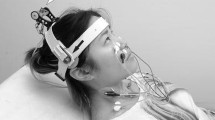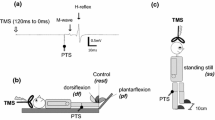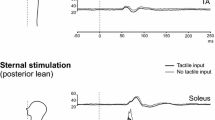Abstract
Application of a small (around 1 mA), constant electric current between the mastoid processes (galvanic stimulation) of a standing subject produces enhanced body sway in the approximate direction of the ear behind which the anode is placed. We examined the electromyographic (EMG) responses evoked by such stimulation in the soleus and in the triceps brachii muscles. For soleus, subjects stood erect, with their eyes closed, leaning slightly forward. The head was turned approximately 90° to the right or left relative to the feet. In averaged records (n=40), current pulses of 25 ms or longer modulated the EMG in a biphasic manner: a small early component (latency 62±2.4 ms, mean ± SEM) was followed by a larger late component (latency 115±5.2ms) of opposite sign, which was appropriate to produce the observed body sway. The early component produced no measurable body movement. Lengthening the duration of the stimulus pulse from 25 to 400 ms prolonged the late component of the response but had little effect on the early component. Short- and long-latency EMG responses were also evoked in the triceps brachii muscle if subjects stood on a transversely pivoted platform and had to use the muscle to maintain their balance in the anteroposterior plane by holding a fixed handle placed by the side of their hip. The latency of the early component was 41±2.6 ms; the latency of the late component was 138±4.3 ms and was again of appropriate sign for producing the observed body sway. Galvanic stimulation evoked no comparable responses in either triceps brachii or soleus muscles if these muscles were not being used posturally. The responses were most prominent if vestibular input provided the dominant source of information about postural stability, and were much smaller if subjects lightly touched a fixed support or opened their eyes. The difference in latency between the onset of the early component of the response in arm and leg muscles suggests that this part of the response uses a descending pathway which conducts impulses down the spinal cord with a velocity comparable with that of the fast conducting component of the corticospinal tract. The late component of the EMG response occurs earlier in the leg than the arm. We suggest that it forms part of a patterned, functional response which is computed independently of the early component.
Similar content being viewed by others
References
Allum JHJ, Honegger F, Pfaltz CR (1989) The role of stretch and vestibulo-spinal reflexes in the generation of human equilibrating reactions. Prog Brain Res 80: 399–409
Allum JHJ, Pfaltz CR (1985) Visual and vestibular contributions to pitch sway stabilization in the ankle muscles of normals and patients with bilateral peripheral vestibular deficits. Exp Brain Res 58: 82–94
Baldissera F, Cavallari P, Tassone G (1990) Effects of transmastoid electrical stimulation of the triceps brachii EMG in man. Neuroreport 1: 191–193
Boyle R, Pompeiano O (1981) Convergence and interaction of neck and macular vestibular inputs on vestibulospinal neurons. J Neurophysiol 45: 852–868
Britton TC, Brown P, Day BL, Marsden CD, Rothwell JC, Thompson PD (1990) Patterned electromyographic responses to galvanic ear stimulation in man. J Physiol (Lond) 420:18P
Breuer J (1889) Neue Versuche an den Ohrbogengangen. Arch Gesammte Physiol 44: 135–152
Brodal A (1981) Neurological anatomy in relation to clinical medicine, 3rd edn. Oxford University Press, New York
Bussel B, Katz R, Pierrot-Deseilligny E, Bergego C, Hayat A (1980) Vestibular and propriospinal influences on the postal reaction to a sudden body displacement in man. In: Desmedt JE (ed) Spinal and supraspinal mechanisms of voluntary motor control and locomotion (Progress in clinical neurophysiology, vol 8) Karger, Basel, pp 310–322
Coats AC, Stoltz MS (1969) The recorded body sway response to galvanic stimulation of the labyrinth: a preliminary study. Laryngoscope 79: 85–103
Day BL, Dressler D, Maertens de Noordhout A, Marsden CD, Nakashima K, Rothwell JC, Thompson PD (1989) Electric and magnetic stimulation of human motor cortex: surface EMG and single motor unit responses. J Physiol (Lond) 412: 449–473
Delwaide PJ, Delbecq P (1973) Vestibular influences on proprioceptive reflexes of the lower limb in normal man. In: Desmedt JE (ed) New developments in electromyography and clinical neurophysiology, vol 3. Karger, Basel, pp 336–341
Devito RV, Brusa A, Arduini A (1956) Cerebellar and vestibular influences on Deitersian units. J Neurophysiol 19: 241–253
Dieterich M, Brandt T, Fries W (1989) Otolith function in man: results from a case of otolith Tullio phenomenon. Brain 112: 1377–1392
Goldberg JM, Fernandez C, Smith CE (1982) Responses of vestibular nerve afferents in the squirrel monkey to externally applied galvanic currents. Brain Res 252: 156–160
Greenwood R, Hopkins A (1976) Muscle responses during sudden falls in man. J Physiol (Lond) 254: 507–518
Grillner S, Hongo T, Lund S (1971) Convergent effects on alpha motoneurones from the vestibulospinal tract and a pathway descending in the medial longitudinal fasciculus. Exp Brain Res 12: 457–479
Hitzig E (1871) Ueber die beim Galvanisiren des Kopfes entstehenden Störungen der Muskelinnervation und der Vorstellungen vom Verhalten im Ramme. Reicherts du Bois Reymonds Archiv 716–772
Ladpli R, Brodai A (1968) Experimental studies of commissural and reticular formation projections from the vestibular nuclei in the cat. Brain Res 8: 65–96
Lund S, Broberg C (1983) Effects of different head positions on postural sway in man induced by a reproducible vestibular error signal. Acta Physiol Scand 117: 307–309
Marsden CD, Merton PA, Morton HB (1981) Human postural responses. Brain 104: 513–534
Marsden CD, Merton PA, Morton HB (1982) Percutaneous stimulation of spinal cord and brain: pyramidal tract conduction velocities in man. J Physiol (Lond) 328:6P
Melvill-Jones G, Watt DGD (1971) Muscular control of landing from unexpected falls in man. J Physiol (Lond) 210: 729–737
Nashner LM (1977) Fixed patterns of rapid postural responses among leg muscles during stance. Exp Brain Res 30: 13–24
Nashner LM, Wolfson P (1974) Influence of head position and proprioceptive cues on short latency postural reflexes evoked by galvanic stimulation of the human labyrinth. Brain Res 67: 255–268
Pastor MA, Day BL, Marsden CD (1992) Postural responses to galvanic stimulation in patients with Parkinson's disease. In: Woollacott M, Horak F (eds) Posture and gait: control mechanisms, vol 2, pp 319–321
Peterson BW, Abzug G (1975) Properties of projections from vestibular nuclei to medial reticular formation in the cat. J Neurophysiol 38: 1421–1435
Pfaltz CR (1970) The diagnostic importance of nystagmography in the galvanic test. In: Stahle J (ed) Vestibular function on earth and in space. Pergamon, Oxford New York, pp 187–199
Rothwell JC, Thompson PD, Day BL, Dick JPR, Kachi T, Cowan JMA, Marsden CD (1987) Motor cortex stimulation in intact man. 1. General characteristics of EMG responses in different muscles. Brain 110: 1173–1190
Thompson PD, Day BL, Crockard HA, Calder I, Murray NMF, Rothwell JC, Marsden CD (1991) Intra-operative recording of motor tract potentials at the cervico-medullary junction following scalp electrical and magnetic stimulation of the motor cortex. J Neurol Neurosurg Psychiatry 54: 618–623
Stell R, Gresty M, Metcalfe T, Bronstein A (1990) The neurology of short latency activation of muscles in neck and leg in response to sudden onset free fall. In: Brandt T, Paulus W, Bles W, Dieterich M, Krafczyk S, Straube A (eds) Disorders of posture and gait 1990. Thieme, Stuttgart, pp 214–217
Watanabe Y, Mizukoshi K, Ohi H, Yasuda K, Ohashi N, Kobayashi H (1989) Retrolabyrinthine disorders detected by galvanic body sway responses in routine equilibrium examinations. Acta Otolaryngol [Suppl] (Stockh) 468: 343–348
Wilson VJ (1991) Vestibulospinal and neck reflexes: interaction in the vestibular nuclei. Arch Ital Biol 129: 43–52
Author information
Authors and Affiliations
Rights and permissions
About this article
Cite this article
Britton, T.C., Day, B.L., Brown, P. et al. Postural electromyographic responses in the arm and leg following galvanic vestibular stimulation in man. Exp Brain Res 94, 143–151 (1993). https://doi.org/10.1007/BF00230477
Received:
Accepted:
Issue Date:
DOI: https://doi.org/10.1007/BF00230477




